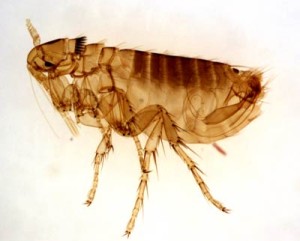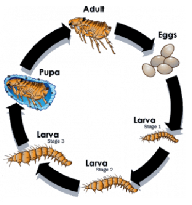Flea Problems at Home?
Flea infestations are usually discovered on Carpets and Rugs, Pets, Car Upholstery and Furniture and Beds.
Getting Rid of Fleas:
Most of the ways to get rid of fleas have to do with cleaning up the house, especially fabric dominant furnishings like carpets, curtains, and most importantly, pets bedding.
-
Daily vacuuming is very important for overall flea eradication. This will pick up (and get rid of) adults, eggs, larvae and pupae before they develop. Putting a flea collar in the vacuum bag and emptying the bag frequently are also important; otherwise, the fleas will hatch, develop, and leave the vacuum to re-infest the living quarters. Dispose of the vacuum bag properly and frequently.
-
Wash all bedding, clothing, and removable furniture covers regularly, weekly if possible.
-
Pets too need thorough clean up to avoid flea infestations. The best remedy is to regularly brush your pet with a flea comb, with some petroleum jelly on it, specially checking in areas between toes, underarms and behind ears. Giving a daily bath is also a good idea since fleas cannot live in water. While brushing them out be sure that the dead or sticking fleas are collected in a mug of water that is immediately flushed down the toilet so they cannot jump out again. However in case of severe infestation, it is advisable to see a vet and get proper medication under medical supervision.
Flea control in your home must address all stages of this life cycle to stop the problem of a flea infestation.
Only about 10% of the flea population (mainly the adults) are on your pet. The flea eggs, larvae, pupa, and the few adults that reside in the carpeting, bedding, and living areas make up approximately 90% of the flea population. Neglecting this population of fleas will ensure that the flea problem will continue and worsen over time.
The most important thing is to remember that once the cleanup process starts, it will have to include fleas from all life stages. Eggs will have to be scrubbed out, larvae and pupae removed and adult fleas destroyed.
The vacuum cleaner will be a handy tool for cleaning up the carpets and furniture. Using disposable dust bags for the cleaner will ensure that the fleas cleaned out will not find their way back in. Always remember to vacuum clean under couches and beds. However, to remove eggs and larvae, the vacuum cleaner may not suffice.
Adult fleas can be flushed out easily but the larvae can’t, so the option is to shampoo the carpets regularly. Some carpet cleaning chemicals may also help, for instance, try spraying diatomaceous earth (DE) on the carpets, in cracks and crevices of furniture and all over rugs. In fact rugs should be machine washed regularly, and so should bedding of pets.
One could opt for borate based carpet cleaners, or borate powder can be mixed in a rug shampooing machine for cleaning up the rug well off flea eggs and larvae.
A good strategy will be to combine a chemical that kills adult fleas with insect development inhibitors like Mithoprene and Pyriproxyfen that will prevent the eggs and larvae from developing into adults. Borate based powders are also effective against fleas for up to one year. There is no need for steam cleaning after applying these but be sure to spread it well, under beds, couches and all over rugs and carpets. All of these chemical treatments should be followed by thorough vacuuming.
Of course, severe infestation needs professional consultation. To keep your carpet free of fleas the best idea is to regularly shampoo and vacuum the mats and upholstery.
When it comes to flea extermination there are many options, including non-toxic Diatomaceous Earth (DE), foggers and flea bombs, or treatments by a professional exterminator. Follow all instructions very carefully; remove all pets, people, and cover all food in the environment before applying insecticide. Make sure everything is dry and it is safe to return according to package directions. Take special precautions for pets and children – eating or putting items in their mouth, etc.




































































